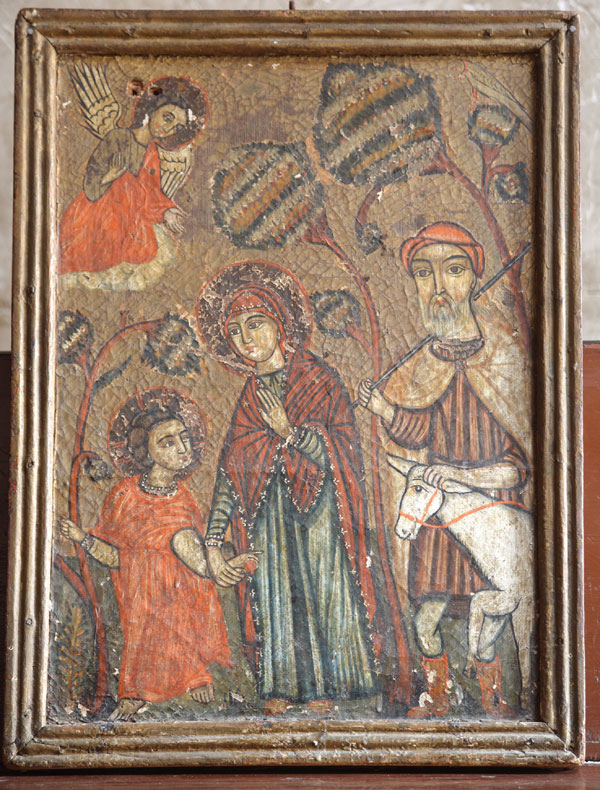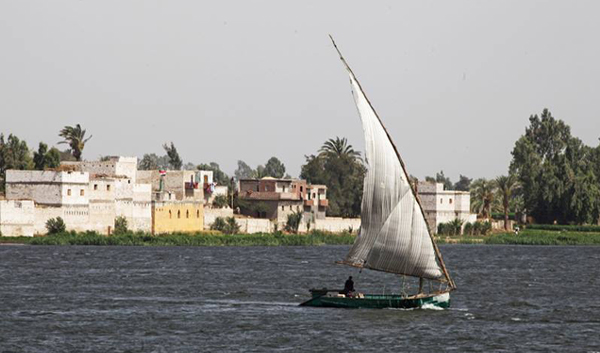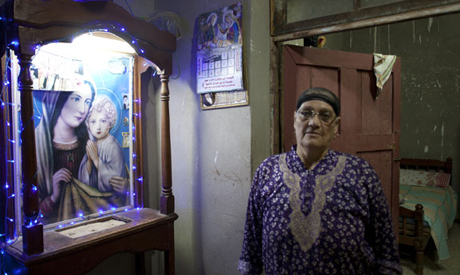“When we get back from church on Joyous Saturday, we light candles as we break our fast; it is a tradition in my family, as well as my husband’s, to light candles on Easter’s eve. We have to buy new candles; it is a tradition that I’d like to keep,” Nadia said.
Nadia’s family purchases lanterns for three Christian occasions: Christmas, Baptism Day and Joyous Saturday.
Palms, lanterns and candles
Buying candles for Joyous Saturday and palm crowns and crosses for Easter Sunday, wearing kohl (traditional black eyeliner) on the morning of Joyous Saturday, and putting olives on the lunch table on Palm Sunday are some of the most obvious and well-known traditions associated with Easter in Egypt.
These traditions are deeply rooted in the history of Christians in Egypt. According to a recent research paper by anthropology researcher Nevine Gergis, these traditions have existed since the early days of Christianity in the country and have been observed almost uninterrupted over the centuries.
“Throughout the generations, my family has been in the business of making crowns and crosses from palms. We collect the palm leaves just a few days before Palm Sunday and we start working on the crowns and crosses to have them ready for sale starting the eve of Palm Sunday until the early afternoon of the holiday itself,” Maged said as he finished his sales late on Palm Sunday morning in front of the Mar Morkos Church in Heliopolis.
According to Maged, the Palm Sunday festivities are perhaps the most famous element of Christian tradition in Egypt – much more known than the orange skin lanterns that are made at Christian houses for children to celebrate the baptism of Jesus.
“Not so many people, especially in the big cities, keep the tradition of the orange lantern; it has been dwindling through generations. Not many would know how to skillfully peel the skin of an orange to turn it into a lantern,” she said.
Maged added, however, that “certainly the majority would observe the day with a meal of taro. I actually know many Muslim families who cook taro for the day.”
She argued that “special foods for special religious occasions are more observed today, especially with the fasts; and they are certainly more known across the Christian and Muslim communities.”
There is no official figure for the number of Christians in Egypt, but the widely accepted estimate is around 10 percent of the population.
Egyptian Christians are mostly Coptic Orthodox, with a small minority of Catholics and Evangelicals. Coptic Orthodox Christians are believed to make up around 98 percent of Egyptian Christians, with the remaining 2 percent being Catholics, Evangelicals, and Orthodox and Catholic Armenians.
Egyptian Christian traditions are mostly observed by Orthodox Copts. These traditions – most of which are food related – are for the most part of purely Egyptian origin, with some aspects introduced by followers of other churches, especially during the 18th and 19th centuries.
In his book ‘Food for the Copt,’ Charles Akl describes “Coptic Cuisine,” which he associates with excessive austerity and an aversion to flare, which could be the result of the many long fasts observed by the followers of the Orthodox Church in Egypt; one of the most well-known elements of Coptic culture.
“It certainly varies from one home to another and from one group of Coptic Christians to another, but for the most part, or at least from what I’ve seen, there are some widely shared elements of this cuisine that truly earn the ‘Coptic food’ label,” Akl said at a recent book discussion hosted by his publisher Kotobkhan.
Akl says that his book is not meant to be an introduction to any elements of Coptic culture. He describes it as more of a “fun book about food from the perspective of a man who grew up in a Coptic family that is not strictly observing.” The book is one of the few easy-to-read works in the contemporary library on Coptic culture that is not related to theology.
The route of the Holy Family

A rare icon of the Holy Family leaving (Photo: Sherif Sonbol)
In the second week of March, the Coptic Studies Programme of the Bibliotheca Alexandrina hosted its second annual conference to revive and preserve Coptic heritage.
According to the organisers of the one-day event, which was held this year in Old Cairo, the lack of attention to “Coptic heritage as one of the main elements of collective Egyptian heritage” is a deficiency that should be addressed.
Speakers at the event argued that there is a growing realisation, at both the public and governmental levels, that the Coptic culture of Egypt should receive more attention – with many suggesting that this would be impossible in the continued absence of any significant information about the history of Christians in Egypt in school curricula as well as in media.
They also agreed that the ongoing effort by the state to promote tours that retrace the flight of the Holy Family through Egypt could serve as a good start for raising awareness about the Coptic era of Egyptian history, which starts with the arrival of the apostle St Mark to Egypt in the first century until the arrival of the Arabs in the seventh century.
Maged El-Raheb, a member of a steering committee established by the government last year to refurbish the “13 acknowledged stops” of the flight of the Holy Family, said that “three stops [along the tour] are now ready to receive the first group of tourists starting May this year.”
The route of the flight of the Holy Family tour goes to Egypt’s eastern desert, Upper Egypt and back.
According to El-Raheb, the stops on the tour currently include sites in Old Cairo, the Virgin Mary Church in Maadi, and the monastery of Wadi El-Natroun.
“These few stops are already attracting so many tourists, and I am sure as we move on with more spots we will get more tourists,” he said.
El-Rehab, who is also head of the Association for the Preservation of Egyptian Heritage, is convinced that attracting tourists to the path of the Holy Family “would certainly help increase the interest to learn more about Coptic heritage.”
He argued that with the growing economic potential of the Coptic monuments, there will be more attention given by the public and the government to these monuments and to Coptic heritage at large.

A stained glass depicting the Holy Family journey (Photo: Sherif Sonbol)
Revisiting Coptic heritage
Bassem El-Sharkawy, professor of Egyptology and Coptic studies, believes that in the minds of many, Coptic heritage is about theology or monuments, which essentially boils down to old churches and monasteries.
“There is hardly any attention given to the many elements of this heritage, including the Coptic language, art, architecture, anthropology, or for that matter Coptic history itself, which is the history of Egyptian Christians and their many contributions, which go way beyond the religious sphere.”
Ishak Agabani, professor of history at the Coptic Studies Institute, which is affiliated with the Coptic Cathedral, agrees that most people “tend to think that Coptic history is the history of the Church rather than the history of the people – when in fact it is about both.”
Art blogger Magda Sidhom says that “Christians were not just praying and fasting; they were writing, drawing, building, and doing all sorts of things; but we tend to see the history of Christians as reduced strictly to theology – not just by the state but by the Church itself. The clergymen are so focused on matters of theology and nothing else, even when it comes to elements of art related to churches and monasteries, like the icons and the paintings.”
Wagdi Habashi, an artist with an established name in “Coptic painting,” agrees that there is a declining interest in art among the clergy. He suggests that perhaps this is the reason behind the almost self-imposed restriction on creativity by many artists.
“The Bible is so full of stories that can be painted and characters and events that can be turned into icons, but at the end of the day, we only have a specific set of icons and paintings that are repeated over and over again with very little room for artistic innovation and creation,” he said.
This, Habashi said, is a function of the declining interest in art in general and the limited attention dedicated in fine art schools to Coptic paintings and icons, which “are absolutely inspiring, starting with the globally celebrated portraits of Fayoum and beyond.”
“We need to have more exhibitions and more art awareness in general,” Habashi said.
According to El-Sharkawy, “there needs to be wider public awareness about art venues, including Coptic art, especially the Coptic Museum, which has a wealth of material that showcases the history of Egyptian Christians, more in the popular sense rather than through the theology angle.”
El-Sharkqawy added that there needs to be more attention to teaching Coptic history and language – “again, not as Christian material, but as anthropology.”
“We need to look at the kind of pots that were used for the cooking of different recipes and the kind of jewelry associated with specific occasions, as well as the manuscripts written in the Coptic language, either for theological or secular purposes,” he said.
This, he added, could not happen under the current deficit in teaching the Coptic language, “which is effectively the evolution of the old Egyptian language; it is not a Christian language.”
The bible was not fully translated into the Coptic language from biblical Hebrew until the second half of the second century. And it was only in the 19thcentury, upon the direct attention of Pope Cyril IV, that the hymns were preserved through one-on-one teaching from masters to pupils; this tradition is still kept in Egyptian churches today for members of the choirs.
Meanwhile, Coptic language classes are essentially available in only two places: the Institute for Coptic Studies and the Center for Coptic Language, which stand next to one another near the Coptic Cathedral in Abbassiya.
The first teaches the language in its more common spoken dialect, while the latter teaches it in the more traditional form. The first is used for prayers, while the second is used to recite old manuscripts.
“Neither could substituted for the other, and neither covers the evolution of the Coptic language; therefore there needs to be a section for the Coptic language in schools of art, archeology and linguistics, as is the case at departments for the Roman and Greek languages,” El-Sharkawy suggested.
He added that the language would otherwise eventually dwindle into oblivion, which would cripple the ability to decipher any as of yet undiscovered manuscripts that could help us learn more about the norms and events of the Coptic era and the wealth of material that continued to be documented in the Coptic language after the arrival of the Arabs to Egypt in the seventh century.

A picture of a felucca taken in front of Gabal al-Tayr in Upper Egypt, one of the locations that the Holy Family visited (Photo: Sherif Sonbol)
_____________________
http://english.ahram.org.eg/News/297172.aspx





